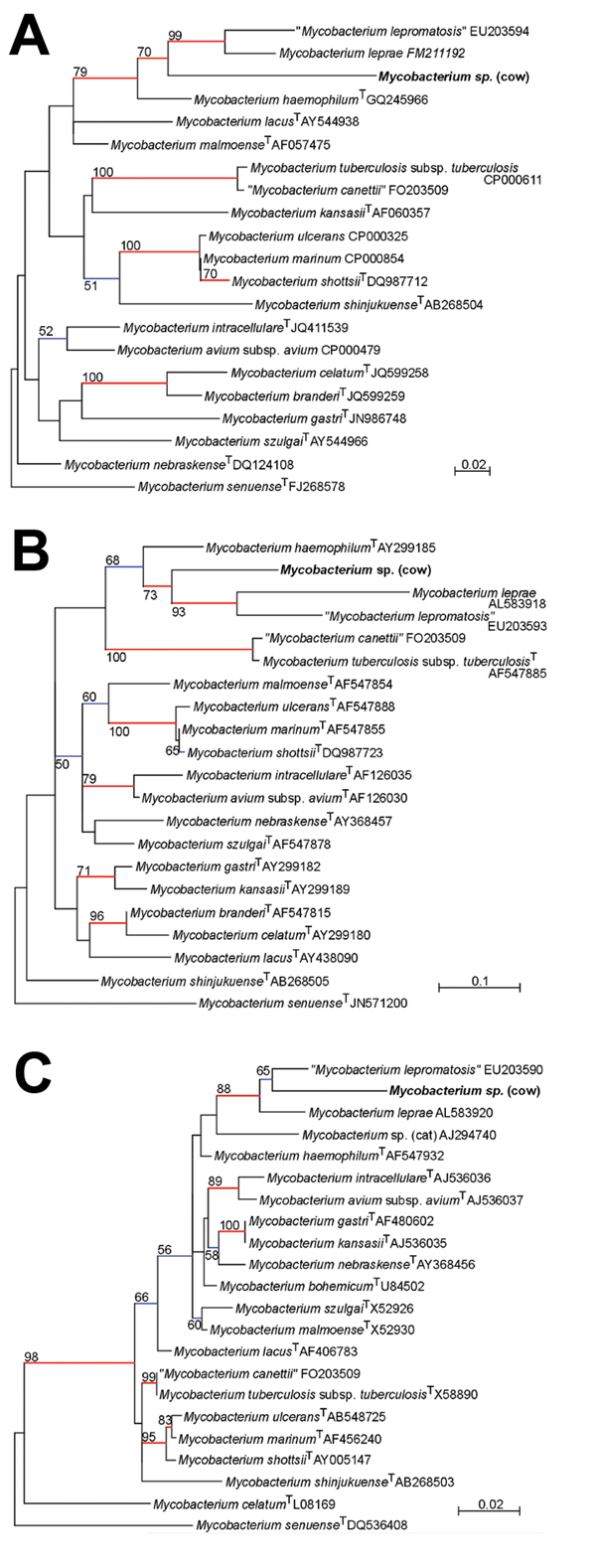Volume 20, Number 12—December 2014
Dispatch
Mycobacterium Species Related to M. leprae and M. lepromatosis from Cows with Bovine Nodular Thelitis
Figure 2

Figure 2. A) Phylogenetic trees based on partial A) β-subunit of RNA polymerase, B) partial heat shock protein 65 sequences, and C) partial 16S rRNA gene sequences of Mycobacterium spp., Jura, France. Phylogenies were inferred by using PhyML (http://code.google.com/p/phyml/) with the general time reversible evolutionary model (7). Trees were rooted by using M. setuense as an outgroup. Strains isolated in this study are indicated in bold. Values along the branches are bootstrap values (bootstrapped 1,000 times). Branches in blue indicate bootstrap values >50% and branches in red indicate bootstrap values >70%. Scale bars indicate estimated nucleotide substitutions per site.
References
- Elston D. Nontuberculous mycobacterial skin infections. Am J Clin Dermatol. 2009;10:281–5 . DOIPubMedGoogle Scholar
- Thorel M-F, Morand M, Fontaine J-J, Gourreau J-M. Bovine nodular thelitis: a clinicopathological study of 20 cases. Vet Dermatol. 1990;1:165–70. DOIGoogle Scholar
- Yachida S, Shimizu K, Hirose T, Sato M. Studies on mycobacteria isolated from skin lesion tuberculosis of the bovine udder. Nihon Juigaku Zasshi. 1973;35:357–65.
- Rüsch P, Corboz L, Ossent P, Berchtold M, Ehrensperger F. Enzootic nodular-ulcerative mamillitis in dairy cows caused by unclassified mycobacteria [in German]. Schweiz Arch Tierheilkd. 1984;126:467–78 .PubMedGoogle Scholar
- Mignard S, Flandrois J-P. A seven-gene, multilocus, genus-wide approach to the phylogeny of mycobacteria using supertrees. Int J Syst Evol Microbiol. 2008;58:1432–41. DOIPubMedGoogle Scholar
- Relman DA. Universal bacterial 16S rDNA amplification and sequencing. In: Persing DH, Smith TF, Tenover FC, White TJ, editors. Diagnostic molecular microbiology: principles and applications. Washington (DC): American Society for Microbiology; 1993. p. 489–95.
- Guérin-Faublée V, Flandrois J-P, Pichat C, Boschiroli ML, Lamy B. Mycobacterium bourgelatii sp. nov., a rapidly growing, non-chromogenic species isolated from the lymph nodes of cattle. Int J Syst Evol Microbiol. 2013;63:4669–74. DOIPubMedGoogle Scholar
- Tortoli E. Phylogeny of the genus Mycobacterium: many doubts, few certainties. Infect Genet Evol. 2012;12:827–31 and. DOIPubMedGoogle Scholar
- Malik R, Hughes MS, James G, Martin P, Wigney DI, Canfield PJ, Feline leprosy: two different clinical syndromes. J Feline Med Surg. 2002;4:43–59. DOIPubMedGoogle Scholar
- Han XY, Sizer KC, Thompson EJ, Kabanja J, Li J, Hu P, Comparative sequence analysis of Mycobacterium leprae and the new leprosy-causing Mycobacterium lepromatosis. J Bacteriol. 2009;191:6067–74. DOIPubMedGoogle Scholar
- Han XY, Seo Y-H, Sizer KC, Schoberle T, May GS, Spencer JS, A new Mycobacterium species causing diffuse lepromatous leprosy. Am J Clin Pathol. 2008;130:856–64. DOIPubMedGoogle Scholar
- Lindeboom JA, Bruijnesteijn van Coppenraet LES, van Soolingen D, Prins JM, Kuijper EJ. Clinical manifestations, diagnosis, and treatment of Mycobacterium haemophilum infections. Clin Microbiol Rev. 2011;24:701–17. DOIPubMedGoogle Scholar
- Monot M, Honoré N, Garnier T, Araoz R, Coppée J-Y, Lacroix C, On the origin of leprosy. Science. 2005;308:1040–2. DOIPubMedGoogle Scholar
- Schuenemann VJ, Singh P, Mendum TA, Krause-Kyora B, Jäger G, Bos KI, Genome-wide comparison of medieval and modern Mycobacterium leprae. Science. 2013;341:179–83. DOIPubMedGoogle Scholar
- Cole ST, Eiglmeier K, Parkhill J, James KD, Thomson NR, Wheeler PR, Massive gene decay in the leprosy bacillus. Nature. 2001;409:1007–11. DOIPubMedGoogle Scholar
Page created: November 19, 2014
Page updated: November 19, 2014
Page reviewed: November 19, 2014
The conclusions, findings, and opinions expressed by authors contributing to this journal do not necessarily reflect the official position of the U.S. Department of Health and Human Services, the Public Health Service, the Centers for Disease Control and Prevention, or the authors' affiliated institutions. Use of trade names is for identification only and does not imply endorsement by any of the groups named above.